A Guiding Framework for Process Parameter Optimisation of Thermal Spraying
Abstract
:1. Introduction
2. Process and Equipment Selection Based on Materials
2.1. Materials
2.2. Inert Gases vs. Combustibles—An Educated Choice
2.3. Choices within an Air Plasma Spray Process
2.4. Robots for Coating Development
2.5. Physical Properties and Parameter Correlations
2.6. Spraying Low Melting Point Materials Such as Aluminium
2.7. Process Parameter Development
2.8. Plume Study
3. Plume Monitoring and Process Diagnostics
3.1. Is the Plume Coaxial to the Nozzle Axis?
3.2. Nozzle Design and Health Check of Hardware
3.3. Use of Diagnostic Tools for Reducing Iterations
4. Other Important Considerations
5. Conclusions
Author Contributions
Funding
Institutional Review Board Statement
Informed Consent Statement
Data Availability Statement
Acknowledgments
Conflicts of Interest
References
- Herman, H.; Sampath, S.; McCune, R. Thermal Spray: Current Status and Future Trends. MRS Bull. 2000, 25, 17–25. [Google Scholar] [CrossRef]
- Viswanathan, V.; Katiyar, N.K.; Goel, G.; Matthews, A.; Goel, S. Role of thermal spray in combating climate change. Emergent Mater. 2021, 4, 1515–1529. [Google Scholar] [CrossRef]
- Kumar, S.; Kumar, R. Influence of processing conditions on the properties of thermal sprayed coating: A review. Surf. Eng. 2021, 37, 1339–1372. [Google Scholar] [CrossRef]
- Faisal, N.H.; Prathuru, A.; Ahmed, R.; Rajendran, V.; Hossain, M.; Venkatachalapathy, V.; Katiyar, N.K.; Li, J.; Liu, Y.; Cai, Q.; et al. Application of Thermal Spray Coatings in Electrolysers for Hydrogen Production: Advances, Challenges, and Opportunities. ChemNanoMat 2022, 8, e202200384. [Google Scholar] [CrossRef]
- Faisal, N.H.; Ahmed, R.; Sellami, N.; Prathuru, A.; Njuguna, J.; Venturi, F.; Hussain, T.; Nezhad, H.Y.; Katiyar, N.K.; Goel, S.; et al. Thermal Spray Coatings for Electromagnetic Wave Absorption and Interference Shielding: A Review and Future Challenges. Adv. Eng. Mater. 2022, 24, 2200171. [Google Scholar] [CrossRef]
- Katiyar, N.K.; Goel, G.; Goel, S. Emergence of machine learning in the development of high entropy alloy and their prospects in advanced engineering applications. Emergent Mater. 2021, 4, 1635–1648. [Google Scholar] [CrossRef]
- Mir, A.; Luo, X.; Llavori, I.; Roy, A.; Zlatanovic, D.L.; Joshi, S.N.; Goel, S. Challenges and issues in continuum modelling of tribology, wear, cutting and other processes involving high-strain rate plastic deformation of metals. J. Mech. Behav. Biomed. Mater. 2022, 130, 105185. [Google Scholar] [CrossRef] [PubMed]
- Vardelle, M.; Vardelle, A.; Fauchais, P. Spray parameters and particle behavior relationships during plasma spraying. J. Therm. Spray Technol. 1993, 2, 79–91. [Google Scholar] [CrossRef]
- Crawmer, D.E.; Bartoe, R.L.; Kramer, J. Technical note: Improved universal powder mass flow control for thermal spray applications. Surf. Coat. Technol. 1987, 33, 353–365. [Google Scholar] [CrossRef]
- Devaraj, S.; Anand, B.; Gibbons, M.; McDonald, A.; Chandra, S. Thermal spray deposition of aluminum and zinc coatings on thermoplastics. Surf. Coat. Technol. 2020, 399, 126114. [Google Scholar] [CrossRef]
- Ziegelheim, J.; Lombardi, L.; Cesanek, Z.; Houdkova, S.; Schubert, J.; Jech, D.; Celko, L.; Pala, Z. Abradable Coatings for Small Turboprop Engines: A Case Study of Nickel-Graphite Coating. J. Therm. Spray Technol. 2019, 28, 794–802. [Google Scholar] [CrossRef]
- Tului, M.; Marino, G.; Valente, T. Plasma spray deposition of ultra high temperature ceramics. Surf. Coat. Technol. 2006, 201, 2103–2108. [Google Scholar] [CrossRef]
- Espallargas, N. (Ed.) Future Development of Thermal Spray Coatings; Woodhead Publishing: Sawston, UK, 2015; pp. 281–286. [Google Scholar] [CrossRef]
- McPherson, R. A review of microstructure and properties of plasma sprayed ceramic coatings. Surf. Coat. Technol. 1989, 39–40, 173–181. [Google Scholar] [CrossRef]
- Feuerstein, A.; Knapp, J.; Taylor, T.; Ashary, A.; Bolcavage, A.; Hitchman, N. Technical and Economical Aspects of Current Thermal Barrier Coating Systems for Gas Turbine Engines by Thermal Spray and EBPVD: A Review. J. Therm. Spray Technol. 2008, 17, 199–213. [Google Scholar] [CrossRef]
- Available online: https://www.youtube.com/watch?v=nlDmhM1qhpQ&t=4114s (accessed on 29 January 2023).
- Tikkanen, J.; Gross, K.A.; Berndt, C.C.; Pitkänen, V.; Keskinen, J.; Raghu, S.; Rajala, M.; Karthikeyan, J. Characteristics of the liquid flame spray process. Surf. Coat. Technol. 1997, 90, 210–216. [Google Scholar] [CrossRef]
- Vardelle, A.; Moreau, C.; Akedo, J.; Ashrafizadeh, H.; Berndt, C.C.; Berghaus, J.O.; Boulos, M.; Brogan, J.; Bourtsalas, A.C.; Dolatabadi, A.; et al. The 2016 Thermal Spray Roadmap. J. Therm. Spray Technol. 2016, 25, 1376–1440. [Google Scholar] [CrossRef]
- Pfender, E. Fundamental studies associated with the plasma spray process. Surf. Coat. Technol. 1988, 34, 1–14. [Google Scholar] [CrossRef]
- Lima, R.S. Porous APS YSZ TBC Manufactured at High Powder Feed Rate (100 g/min) and Deposition Efficiency (70%): Microstructure, Bond Strength and Thermal Gradients. J. Therm. Spray Technol. 2022, 31, 396–414. [Google Scholar] [CrossRef]
- Sahraoui, T.; Feraoun, H.I.; Fenineche, N.; Montavon, G.; Aourag, H.; Coddet, C. HVOF-sprayed Tribaloy©-400: Microstructure and first principle calculations. Mater. Lett. 2004, 58, 2433–2436. [Google Scholar] [CrossRef]
- Öksüz, M.; Yıldırım, H.; Erturan, S. Microstructure and wear properties of plasma-sprayed aluminum–silicon–polyester coatings. J. Appl. Polym. Sci. 2006, 100, 3609–3614. [Google Scholar] [CrossRef]
- Karger, M.; Vaßen, R.; Stöver, D. Atmospheric plasma sprayed thermal barrier coatings with high segmentation crack densities: Spraying process, microstructure and thermal cycling behavior. Surf. Coat. Technol. 2011, 206, 16–23. [Google Scholar] [CrossRef]
- Bolelli, G.; Lusvarghi, L.; Manfredini, T.; Pighetti Mantini, F.; Polini, R.; Turunen, E.; Varis, T.; Hannula, S.-P. Comparison between plasma-and HVOF-sprayed ceramic coatings. Part I: Microstructure and mechanical properties. Int. J. Surf. Sci. Eng. 2007, 1, 38–61. [Google Scholar] [CrossRef]
- Jandin, G.; Liao, H.; Feng, Z.Q.; Coddet, C. Correlations between operating conditions, microstructure and mechanical properties of twin wire arc sprayed steel coatings. Mater. Sci. Eng. A 2003, 349, 298–305. [Google Scholar] [CrossRef] [Green Version]
- Zhang, Z.; Zhang, D.; Xie, Y. Experimental study on water droplet erosion resistance of coatings (Ni60 and WC-17Co) sprayed by APS and HVOF. Wear 2019, 432-433, 202950. [Google Scholar] [CrossRef]
- Viswanathan, V.; Rea, K.E.; Vaidya, A.; Seal, S. Role of spray drying of nanoagglomerates in morphology evolution in nanostructured APS coatings. J. Am. Ceram. Soc. 2008, 91, 379–386. [Google Scholar] [CrossRef]
- Brossard, S.; Munroe, P.R.; Tran, A.T.T.; Hyland, M.M. Effects of Substrate Roughness on Splat Formation for Ni-Cr Particles Plasma Sprayed onto Aluminum Substrates. J. Therm. Spray Technol. 2010, 19, 1131–1141. [Google Scholar] [CrossRef]
- Caliari, F.R.; Miranda, F.S.; Reis, D.A.P.; Filho, G.P.; Charakhovski, L.I.; Essiptchouk, A. Plasma torch for supersonic plasma spray at atmospheric pressure. J. Mater. Process. Technol. 2016, 237, 351–360. [Google Scholar] [CrossRef] [Green Version]
- Mauer, G.; Vaßen, R.; Stöver, D. Comparison and Applications of DPV-2000 and Accuraspray-g3 Diagnostic Systems. J. Therm. Spray Technol. 2007, 16, 414–424. [Google Scholar] [CrossRef]
- Zimmermann, S.; Vogli, E.; Kauffeldt, M.; Abdulgader, M.; Krebs, B.; Rüther, B.; Landes, K.; Schein, J.; Tillmann, W. Supervision and Measuring of Particle Parameters During the Wire-Arc Spraying Process with the Diagnostic Systems Accuraspray-g3 and LDA (Laser-Doppler-Anemometry). J. Therm. Spray Technol. 2010, 19, 745–755. [Google Scholar] [CrossRef]
- Mahendru, P.; Tembely, M.; Dolatabadi, A. Artificial Intelligence Models for Analyzing Thermally Sprayed Functional Coatings. J. Therm. Spray Technol. 2023. [Google Scholar] [CrossRef]
- Available online: https://www.youtube.com/@dsmnetwork7248 (accessed on 29 January 2023).
- Available online: https://www.youtube.com/watch?v=c_RyulgFX84 (accessed on 29 January 2023).
- Available online: https://www.youtube.com/watch?v=hBjLwySsYyU (accessed on 29 January 2023).
- Available online: https://www.youtube.com/watch?v=ds7V6t0AYRs&t=41s (accessed on 29 January 2023).
- Soltani, R.; Heydarzadeh-Sohi, M.; Ansari, M.; Afsari, F.; Valefi, Z. Effect of APS process parameters on high-temperature wear behavior of nickel–graphite abradable seal coatings. Surf. Coat. Technol. 2017, 321, 403–408. [Google Scholar] [CrossRef]
- Madhwal, M.; Jordan, E.H.; Gell, M. Failure mechanisms of dense vertically-cracked thermal barrier coatings. Mater. Sci. Eng. A 2004, 384, 151–161. [Google Scholar] [CrossRef]
- Scrivani, A.; Rizzi, G.; Berndt, C.C. Enhanced thick thermal barrier coatings that exhibit varying porosity. Mater. Sci. Eng. A 2008, 476, 1–7. [Google Scholar] [CrossRef]
- Perez, E. Development of APS MCrAlY Dense Bond Coats; Report; University of Central Florida: Orlando, FL, USA, 2006. [Google Scholar]
- Sadeghimeresht, E.; Markocsan, N. Electrochemical Behavior of Bilayer Thermal-Spray Coatings in Low-Temperature Corrosion Protection. Coatings 2017, 7, 162. [Google Scholar] [CrossRef] [Green Version]
- Cabral-Miramontes, J.A.; Gaona-Tiburcio, C.; Almeraya-Calderón, F.; Estupiñan-Lopez, F.H.; Pedraza-Basulto, G.K.; Poblano-Salas, C.A. Parameter Studies on High-Velocity Oxy-Fuel Spraying of CoNiCrAlY Coatings Used in the Aeronautical Industry. Int. J. Corros. 2014, 2014, 703806. [Google Scholar] [CrossRef] [Green Version]
- Dvorak, M.; Florin, C.; Amrhein, E. Online Quality Control of Thermally Sprayed Coatings. Therm. Spray 2001, 1255–1259. [Google Scholar]
- Kucuk, A.; Berndt, C.C.; Senturk, U.; Lima, R.S. Influence of plasma spray parameters on mechanical properties of yttria stabilized zirconia coatings. II: Acoustic emission response. Mater. Sci. Eng. A 2000, 284, 41–50. [Google Scholar] [CrossRef]
- Faisal, N.H.; Steel, J.A.; Ahmed, R.; Reuben, R.; Heaton, G.; Allcock, B. Application of acoustic emission for monitoring the HVOF thermal spraying process. Adv. Mater. Res. 2006, 13–14, 291–298. [Google Scholar]
- Kamnis, S.; Malamousi, K.; Marrs, A.; Allcock, B.; Delibasis, K. Aeroacoustics and Artificial Neural Network Modeling of Airborne Acoustic Emissions During High Kinetic Energy Thermal Spraying. J. Therm. Spray Technol. 2019, 28, 946–962. [Google Scholar] [CrossRef]
- Mauer, G.; Moreau, C. Process diagnostics and control in thermal spray. J. Therm. Spray Technol. 2022, 31, 818–828. [Google Scholar] [CrossRef]
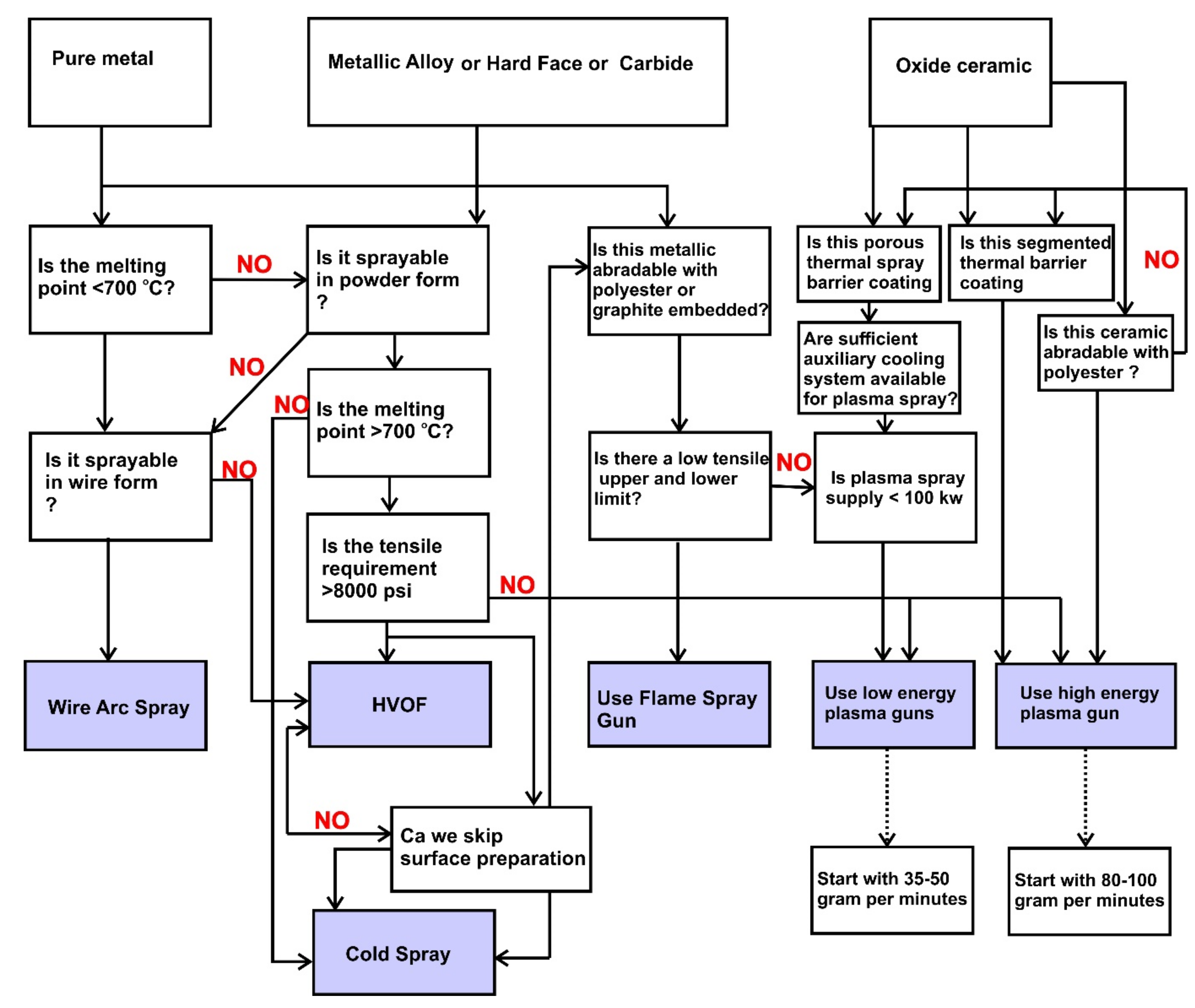

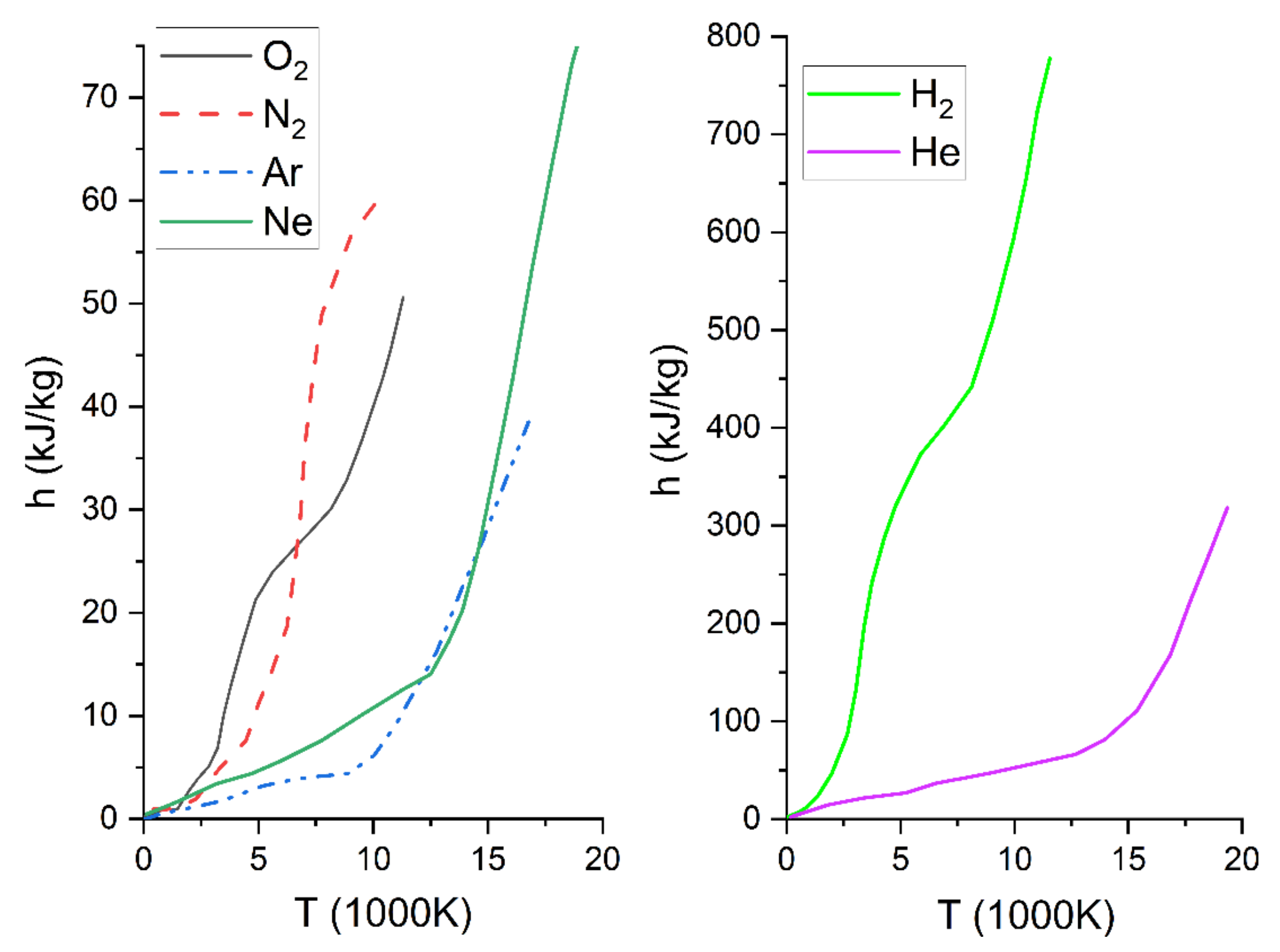


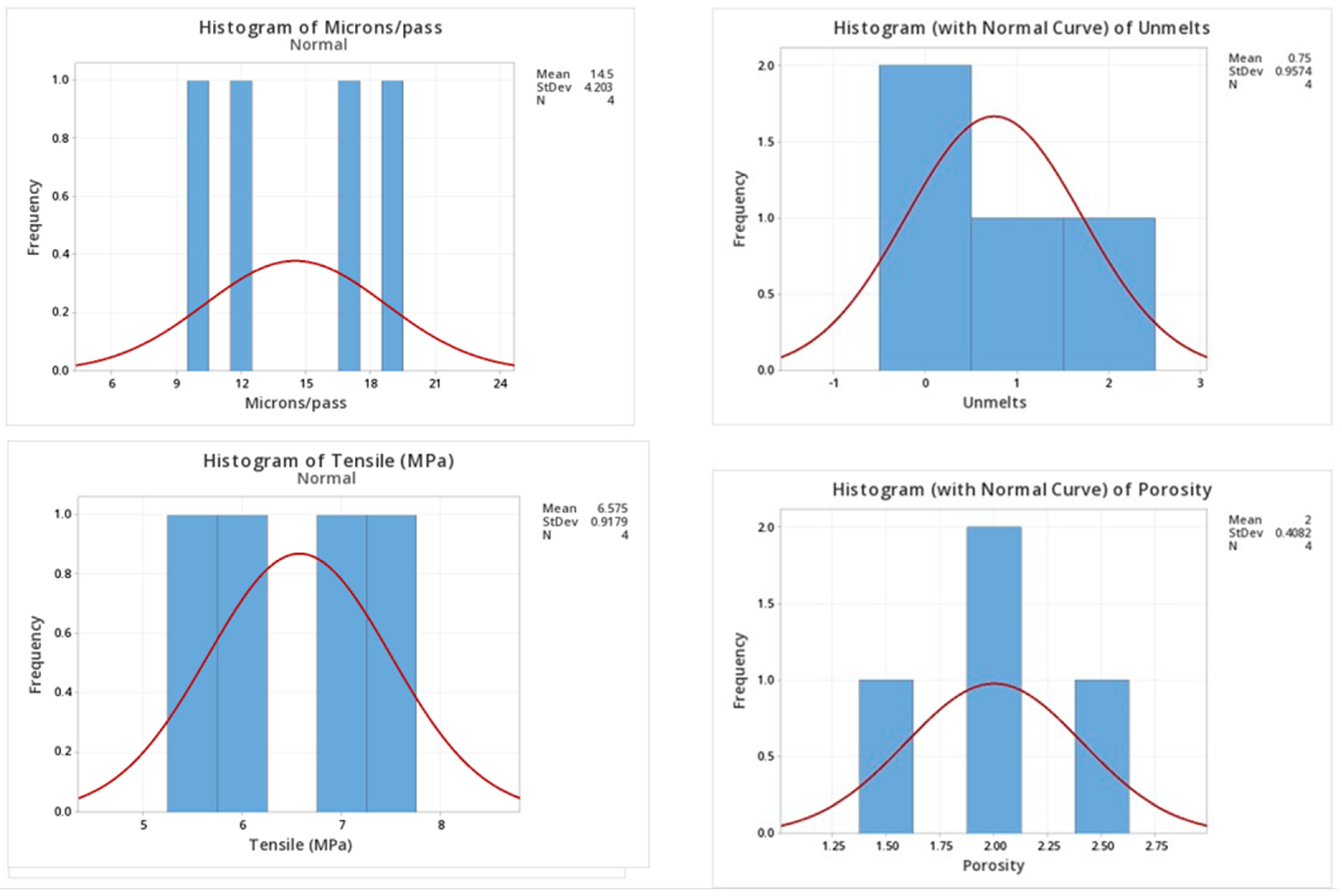
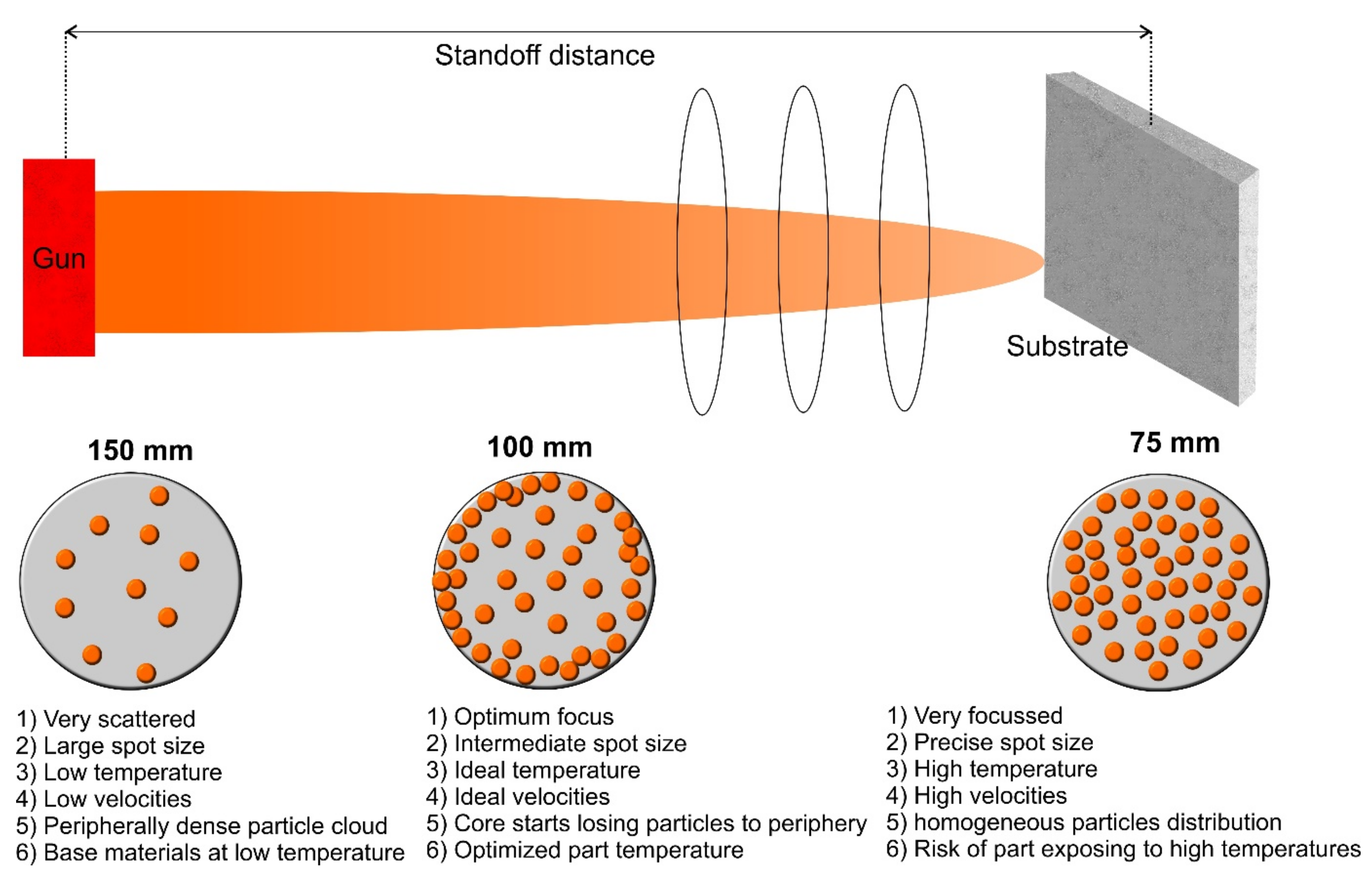
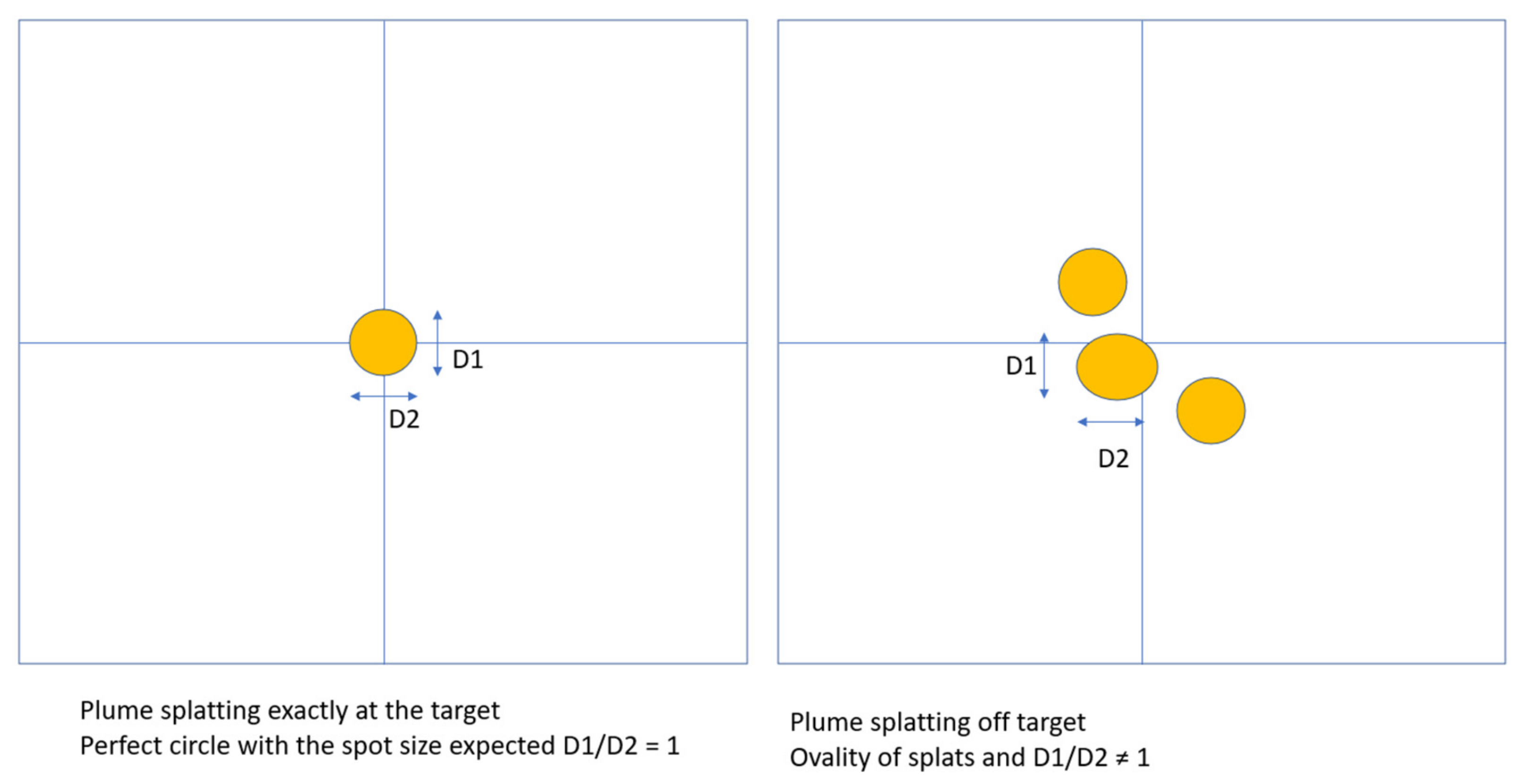
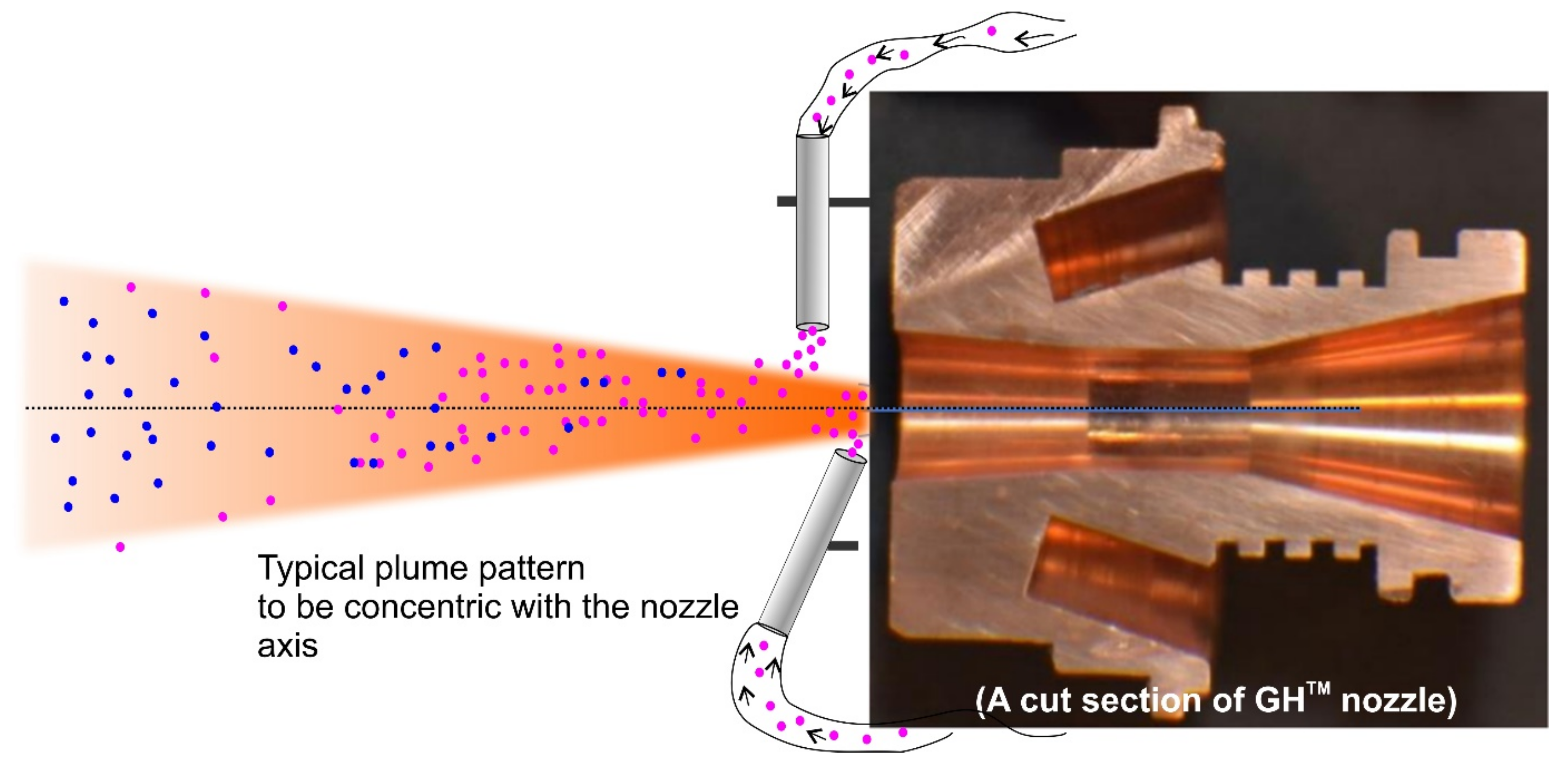

| Nitrogen (SLPM) | Hydrogen (SLPM) | Standoff (mm) | Carrier gas (SLPM) | Current (Amps) | Voltage (V) | Power (kW) | Feedrate (g/min) | Unmelts | Porosity (%) | Microns/Pass | Tensile (MPa) |
|---|---|---|---|---|---|---|---|---|---|---|---|
| 33 | 1.5 | 100 | 3 | 400 | 30 | 12 | 35 | 3 | 4.0 | 10 | 5.5 |
| 33 | 2.5 | 80 | 4 | 400 | 37 | 15 | 35 | 2 | 3.0 | 12 | 6.2 |
| 38 | 4.5 | 90 | 4 | 400 | 40 | 16 | 38 | 1 | 2.5 | 17 | 7 |
| 38 | 5 | 100 | 4 | 400 | 50 | 20 | 45 | 0 | 2.0 | 19 | 7.6 |
| Variable | N | N* | Mean | SE Mean | St. Dev | Min | Q1 | Median | Q3 | Max |
|---|---|---|---|---|---|---|---|---|---|---|
| Unmelts | 4 | 0 | 0.75 | 0.479 | 0.957 | 0.00 | 0.00 | 0.500 | 1.750 | 2.0 |
| Porosity | 4 | 0 | 2 | 0.204 | 0.408 | 1.500 | 1.625 | 2.00 | 2.375 | 2.5 |
| Microns/pass | 4 | 0 | 14.5 | 2.1 | 4.2 | 10 | 10.5 | 14.5 | 18.5 | 19 |
| Tensile (MPa) | 4 | 0 | 6.575 | 0.459 | 0.918 | 5.5 | 5.675 | 6.6 | 7.45 | 7.6 |
| Microstructural Feature and Mechanical Properties | Spray Distance  | Robot Speed | Off-Gun Angle (Deviating from 90°) | Primary Gas | Secondary Gas | Clean Grit Blasting |
|---|---|---|---|---|---|---|
| Oxide |  |  |  |  |  |  |
| Porosity |  |  |  |  |  |  |
| Interface Quality |  |  |  |  |  |  |
| Unmelts |  |  |  |  |  |  |
| Tensile Strength |  |  |  |  |  |  |
| Hardness |  |  |  |  |  |  |
 —Increase,
—Increase,  —No Effect,
—No Effect,  —Decrease.
—Decrease.Disclaimer/Publisher’s Note: The statements, opinions and data contained in all publications are solely those of the individual author(s) and contributor(s) and not of MDPI and/or the editor(s). MDPI and/or the editor(s) disclaim responsibility for any injury to people or property resulting from any ideas, methods, instructions or products referred to in the content. |
© 2023 by the authors. Licensee MDPI, Basel, Switzerland. This article is an open access article distributed under the terms and conditions of the Creative Commons Attribution (CC BY) license (https://creativecommons.org/licenses/by/4.0/).
Share and Cite
Venkatachalapathy, V.; Katiyar, N.K.; Matthews, A.; Endrino, J.L.; Goel, S. A Guiding Framework for Process Parameter Optimisation of Thermal Spraying. Coatings 2023, 13, 713. https://doi.org/10.3390/coatings13040713
Venkatachalapathy V, Katiyar NK, Matthews A, Endrino JL, Goel S. A Guiding Framework for Process Parameter Optimisation of Thermal Spraying. Coatings. 2023; 13(4):713. https://doi.org/10.3390/coatings13040713
Chicago/Turabian StyleVenkatachalapathy, Viswanathan, Nirmal Kumar Katiyar, Allan Matthews, Jose Luis Endrino, and Saurav Goel. 2023. "A Guiding Framework for Process Parameter Optimisation of Thermal Spraying" Coatings 13, no. 4: 713. https://doi.org/10.3390/coatings13040713









